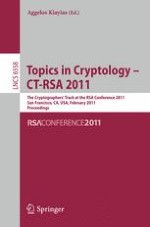This book constitutes the refereed proceedings of the Cryptographers' Track at the RSA Conference 2011, CT-RSA 2011, held in San Francisco, CA, USA, in February 2011.
The 24 revised full papers presented together with 1 invited lecture were carefully reviewed and selected from 79 submissions. The papers are organized in topical sections on secure two-party computation, cryptographic primitives, side channel attacks, authenticated key agreement, proofs of security, block ciphers, security notions, public-key encryption, crypto tools and parameters, and digital signatures.
